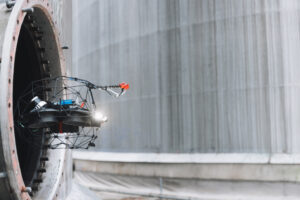Wall thickness measurements of tanks and pipelines should be regularly checked.

Wall thickness measurements are crucial for assessing the integrity of a tank or a pipeline. These measurements help engineers and technicians identify thinning materials, corrosion, and wear, which can lead to potential safety risks and operational downtime. Traditional methods for wall thickness measurements often required inspectors to manually reach the locations, which can be time-consuming, expensive and sometimes dangerous.
Ultrasonic wall thickness measurements and drones: an innovative combination
Ultrasonic wall thickness measurements are one of the most accurate methods for measuring the thickness of materials. Ultrasonic sensors send sound waves through the material, and based on the reflection of these waves, technicians can determine the thickness of the material. When this technology is combined with drones, it opens up a world of possibilities for fast and efficient inspections.
The most notable benefits are the elimination of the need for scaffolding and the avoidance of entry into a confined space, thereby saving on confined space attendants.

Wall thickness measurements in Petrochemicals and Tank Terminals
In the petrochemical industry and tank terminals, wall thickness measurements play a crucial role in ensuring the safety and reliability of installations and storage tanks. These facilities contain a wide range of equipment, pipelines and tanks that are exposed to various environmental factors and chemicals, making them susceptible to corrosion and material weakening.
They are also of paramount importance in ensuring the integrity of tanks and pipelines. Corrosion can occur due to the chemical processes occurring in the installations, as well as due to the storage of corrosive liquids and gases. Therefore, regular inspection of wall thicknesses is essential to identify potential issues before they lead to leaks, failures or even catastrophic incidents.
By using drones for ultrasonic wall thickness measurements, petrochemical companies and tank terminal operators can enhance their inspection processes and increase the safety of their installations. Drones and crawlers can inspect large areas quickly and efficiently, including tanks and pipelines that are difficult to access for manual inspection methods.
By conducting regular ultrasonic wall thickness measurements, operators can detect potential issues at an early stage, take corrective actions, and minimize unplanned downtime. This not only helps improve operational efficiency but also ensures the safety of employees, the environment, and the community.



